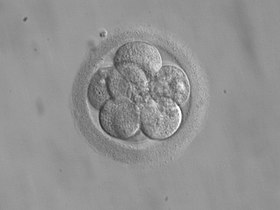Embryo transfer
| Embryo transfer | |
|---|---|
| Intervention | |

8-cell embryo for transfer 3 days after fertilization
|
|
| MeSH | D004624 |
Embryo transfer refers to a step in the process of assisted reproduction in which embryos are placed into the uterus of a female with the intent to establish a pregnancy. This technique (which is often used in connection with in vitro fertilization (IVF)), may be used in humans or in animals, in which situations the goals may vary.
Embryos can be either “fresh” from fertilized egg cells of the same menstrual cycle, or “frozen”, that is they have been generated in a preceding cycle and undergone embryo cryopreservation, and are thawed just prior to the transfer, which is then termed "frozen embryo transfer" (FET). The outcome from using cryopreserved embryos has uniformly been positive with no increase in birth defects or development abnormalities, also between fresh versus frozen eggs used for intracytoplasmic sperm injection (ICSI). In fact, pregnancy rates are increased following FET, and perinatal outcomes are less affected, compared to embryo transfer in the same cycle as ovarian hyperstimulation was performed. The endometrium is believed to not be optimally prepared for implantation following ovarian hyperstimulation, and therefore frozen embryo transfer avails for a separate cycle to focus on optimizing the chances of successful implantation. Children born from vitrified have significantly higher birthweight than those born from non-frozen blastocysts. When transferring a frozen-thawed oocyte, the chance of pregnancy is essentially the same whether it is transferred in a natural cycle or one with ovulation induction.
In the human, the uterine lining (endometrium) needs to be appropriately prepared so that the embryo(s) can implant. In a natural cycle the embryo transfer takes place in the luteal phase at a time where the lining is appropriately undeveloped in relation to the status of the present Luteinizing Hormone. In a stimulated or a cycle where a "frozen" embryo is transferred, the recipient woman could be given first estrogen preparations (about 2 weeks), then a combination of oestrogen and progesterone so that the lining becomes receptive for the embryo. The time of receptivity is the implantation window. A scientific review in 2013 came to the conclusion that it is not possible to identify one method of endometrium preparation in frozen embryo transfer as being more effective than another.
...
Wikipedia
